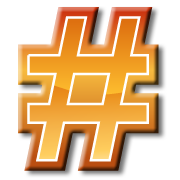 If you’ve been using Twitter for a while, one of the best ways to get even more involved and extend your Twitter reach is to find a hashtag to follow. A hashtag is a # followed by a word or a string of letters and numbers. Many times you can guess what a hashtag might be based on a topic you’re interested in. Hashtags like #leadership, #management, and #entrepreneur are often used by folks who want others with their same interests to connect with their tweets.
If you’ve been using Twitter for a while, one of the best ways to get even more involved and extend your Twitter reach is to find a hashtag to follow. A hashtag is a # followed by a word or a string of letters and numbers. Many times you can guess what a hashtag might be based on a topic you’re interested in. Hashtags like #leadership, #management, and #entrepreneur are often used by folks who want others with their same interests to connect with their tweets.
One of my personal favorite hashtags is #SOBCon, and that stands for Successful Online Business Conference. It’s a conference I attend every year, and people use the hashtag to share posts with the community. For this article, I’ll be using #SOBCon as my hashtag example.
Here are some simple steps to get you started using hashtags more effectively.
Getting Started with Hashtags
0) Get a free HootSuite account, connect it to your Twitter account and put it on your mobile device. It is WAY better than the native Twitter app as it allows you to keep search columns open and make columns of your lists (up to 10).
1) Find out and follow the event hashtag. For SOBCon it is #SOBCon (or #SOBCON or #sobcon since capitalization doesn’t matter). You do this by using the magnifying glass, and search for the hashtag PLUS the phrase. When you have found it, save it as a column.
2) Start following people already using the hashtag, and people mentioned by those using the hashtag. If they’re interesting, follow them. If they’re not, don’t. Going forward, you’ll want to add everyone you follow to a list. You can make up to 20 lists. I’d recommend creating one for thought leaders, a list for conference one, a list for conference two, a list for each topic you’re interested in, etc. And I would make them private for now so you don’t hurt anyone’s feelings who doesn’t make your list.
3) Change the retweet (RT) style to the “classic” style (it’s in the settings) so you can add to/modify the tweet. RT things only when you can add value to the original tweet. If you have thoughts, add them at the beginning – or the end – of the tweet. Just try to be consistent.
4) Share the best information you learn in 110 characters or fewer so folks can RT your tweets. Be sure to mention the person you are quoting at the end with their @ handle (e.g., @PhilGerb). If you don’t know it for sure, do a Google search of their name and the word Twitter. Unless they’re Bob Smith, you’ll find them easily.
For an added bonus: Connect Instagram to Twitter and Facebook so you can share some pictures if you want to. Use hashtags for the event, for the location, etc. Hashtags RULE (though they don’t work yet on Facebook).
While this won’t make you a Twitter expert, you will be much more comfortable using Twitter, and will find people who, like you, have a common interest in the content of a conference. Whether you attend a conference like SOBCon or not, diving into Twitter headfirst like this can make your Twitter experience much more meaningful – and you can use this for any conference or any hashtag that interests you.
Do you use Twitter? Does this post inspire you to start? We’d love to hear about your experiences in the comments below.

